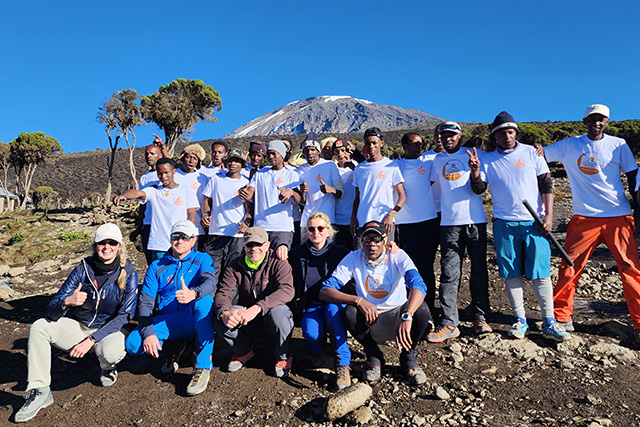Mount Kilimanjaro is not just a mountain; it’s a mosaic of scenic trails, breathtaking landscapes, and diverse ecosystems.
Located in Tanzania, East Africa, Mount Kilimanjaro is the highest mountain on the African continent and the world’s highest free-standing mountain, standing at 5,895 meters (19,341 feet) above sea level. Being the highest peak in Africa, Mount Kilimanjaro is one of the Seven Summits, the highest peaks on each continent. It is a dormant stratovolcano with three volcanic cones: Kibo (the highest and dormant), Mawenzi (the second highest), and the Shira Plateau (the lowest and eroded).
Mount Kilimanjaro has five distinct ecological zones, each with its unique climate, vegetation, and wildlife. As you ascend the mountain, the temperature and conditions change dramatically, making it one of the most ecologically diverse mountains in the world. Those zones are
- Cultivation zone/lower slopes (800 m – 1,800 m / 2,600 ft–5,900 ft). This zone consists mostly of cultivated land where local Chagga people grow crops like bananas, coffee, and maize. It’s warm and dry with farmland, grasslands, and scattered trees.
- Rainforest Zone (1,800m – 2,800m / 5,900ft – 9,200ft). This is the most biodiverse zone, providing lush greenery and high humidity. Most wildlife is found here, though they are rarely seen by trekkers. It’s warm and humid, with frequent and unpredictable rainfall, and a dense tropical forest with tall trees, mosses, and ferns. You will expect to spot wildlife animals in this zone, like blue monkeys, colobus monkeys, leopards, antelopes, and numerous bird species.
- Moorland Zone (2,800m – 4,000m / 9,200ft – 13,100ft). The forest thins out, replaced by shrubs and tall, strange-looking plants adapted to harsh conditions. The landscape becomes more open with rolling hills. It’s cool; with lower humidity and occasional mist, the vegetation in this zone is heather, giant lobelias, giant groundsels, and wildflowers, as well as a few animals: some insects, birds, and rodents
- Alpine Desert Zone (4,000m – 5,000m / 13,100ft – 16,400ft). The landscape is barren, with volcanic rocks and little to no plant life, mostly lichens and mosses. Oxygen levels start to drop significantly, making breathing harder. Typically, it’s very cold at night and sometimes hot during the day, dry and windy.
- Arctic or Glacier Zone (above 5,000 m / 16,400 ft–19,341 ft). This is the summit zone, covered in glaciers, ice fields, and rocky surfaces. Oxygen is only 49% of sea level, making it the most challenging part of the climb. The famous Furtwängler Glacier is found here, though it is shrinking due to climate change. The zone is extremely cold, with freezing temperatures and strong winds and no vegetation.
When climbing Mount Kilimanjaro, no technical climbing is required (hiking, not mountaineering). Usually, the mount can be done in 5-9 days up and down, depending on the selected route, and the summit success rate is higher with longer routes due to better acclimatization.
Common Routes:
- Marangu Route (Coca-Cola Route)—easiest, but less scenic (5-6 days up and down)
- Machame Route (Whiskey Route)—scenic and popular (6-7 days up and down)
- Lemosho Route—long, scenic, high success rate (6-8 days up and down)
- Rongai Route—remote and dry, less crowded (5-7 days up and down)
- Northern Circuit—longest, most gradual, high success rate (9 days up and down)
The first recorded ascent of Mount Kilimanjaro was made by Hans Meyer, a German geographer, and Ludwig Purtscheller, an Austrian mountaineer, on October 6, 1889.
Hans Meyer had attempted to climb Kilimanjaro twice before but failed due to difficulties with terrain, altitude sickness, and lack of proper equipment. On his successful third attempt in 1889, he was joined by Ludwig Purtscheller, an experienced climber, and a local guide, Yohani Kinyala Lauwo, a Chagga tribesman. The team used the Marangu Route and reached the highest point on Kibo, which was later named Uhuru Peak (now recognized as the official summit).
In 1987, Mount Kilimanjaro was declared a UNESCO World Heritage Site. It was recognized for its unique ecological system, diverse wildlife, and cultural significance.
Since then, over 300,000 people from all over the world attempt to summit Mount Kilimanjaro each year, which is why it’s one of the world’s most famous trekking destinations and a popular challenge for climbers.
Are you tempted? Would you like to be one of these people who summit Mount Kilimanjaro each year?
Contact us now to book

